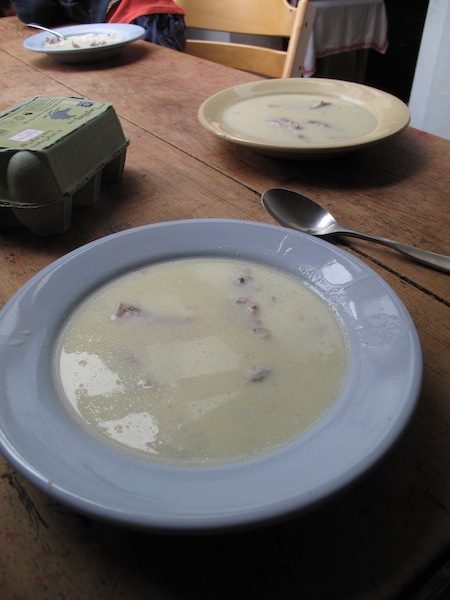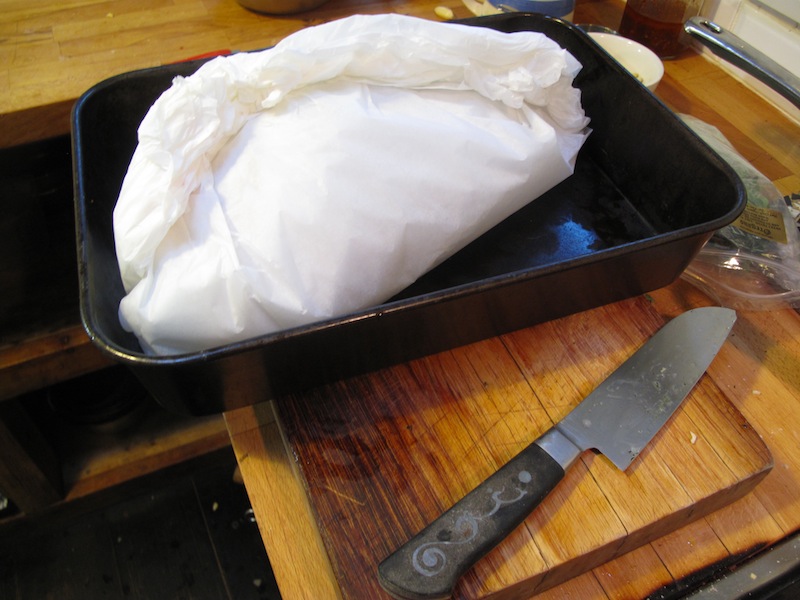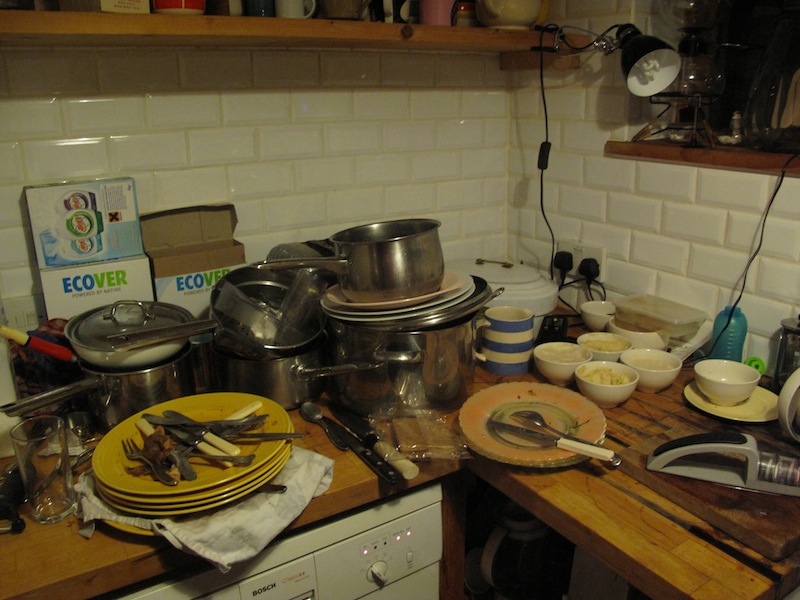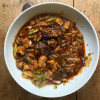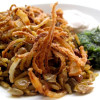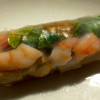 Week four – and our randomly chosen country is Greece! I whooped when that pretty blue and white flag came up as I knew we were on safe ground with some delicious possibilities ahead of us… and it’s been ages since I had an Ouzo.
Week four – and our randomly chosen country is Greece! I whooped when that pretty blue and white flag came up as I knew we were on safe ground with some delicious possibilities ahead of us… and it’s been ages since I had an Ouzo.
Some Greek dishes are now so ubiquitous that they’ve become part of the British diet, even part of our psyche. There is still no better food after the pub than a kebab. There is still no better food to take to work in your packed lunch box when you’re pretending to be on a diet than hummus (which isn’t actually Greek but we’ll let that slide).
There’s a long association with Greek food in this country stemming from the annexation of Cyprus in 1913 and then waves of Greek Cypriots settling in North London from the 1930s onward and then again in the mid-70s following the Turkish invasion.
The two pronged attack of dips and kebabs began in earnest in the 70s as package holidays became cheaper and more popular, with the Greek islands as one of the more exotic destinations.
There is much more to Greek cooking than that of course but those crowd-pleasing dishes are popular for a reason – the Calamari I cooked has been our absolute favourite dish of the 8 countries we’ve done so far: fresh, simple, delicious.
What I love about Greek food is the lack of fuss and the focus on big, fresh flavours from good ingredients – like Italian but less prissy. Nothing I cooked was hard to do and most of the dishes rely on 2 or 3 key ingredients at most. Time for the Greek revival…
Ask A Local
I’m finding that so far it’s been reasonably easy to choose what to have for lunch and dinner but breakfast is more tricky. We seem very hung up on breakfast in this country whereas both Peru and, it turns out, Greece don’t really have much to eat first thing. Why is that? I’m searching for a culinary anthropologist to answer such deep questions so if you know one or are one then drop me a line…
As with Peru last time, I turned to the locals – this time with some more refined questioning of eating habits, recipes and ingredients:
I asked the following questions:
- Can you advise me on any cool stuff I could add to my meal to make it amazing?
- Are there any luxury Greek ingredients the equivalent of truffles, parma ham etc
- What do people in Greece have for breakfast?
- What are the traditional (nice to eat for us!) puddings?
The power of Facebook hooked me up with Alex Papasimakopoulou, who (as if sensing my desire for ultimate authenticity or alternatively just going about her daily business when contacted out of the blue by some random dude demanding to know what she’d had for breakfast) responded while stuck in gridlocked Athenean traffic.
“Greeks don’t really do breakfast, a coffee and a cheese pie at most. I can’t really think of very weird recipes apart from maybe something like Magiritsa which is the traditional meat soup consumed on Easter Saturday. Most Greek recipes are not really that weird. As far as luxury ingredients, you could try a smoked meat from Crete called Apaki if you could find it. Re: puddings, Rizogalo is our version of rice pudding. Other than that most desserts are kind of like Baklava (see below). There is a thing called Diples, which is in the same vein.
I had another great response from Irini Thiakimou which has saved me the trouble of lots of reading and research – thanks Irini!
“Greece is a country with a great amount of islands (1200-6000 depending on the size you take in to account). It is also a country full of mountains. Thus, some places seem to be kind of isolated from the others. Because of this fact one can see great differences in various places of Greece in terms of culture (music, attitudes, cooking, even on the way we look).
Greeks usually have a cup of coffee and rush off to work (that’s the adults) in the morning but a proper Greek breakfast includes:
Paximadia, which is something like dried bread or toast. Children would have cow-milk or goat-milk and the adults coffee or tea (our tea is a herb that we call tea of the mountains, different to yours).
As far as cooking, you will mostly see seafood on the islands (calamari, octopus, fish, prawns etc). What seems to be extreme is that we eat many of the creatures that you can take from the sea such as sea urchins (a great delicacy!!) or limpets, something close to scallops as well as others. I doubt though that you can find anything like it here so I’ll go straight to meat and vegetables.
Here are some more recipes that Irini sent me:
Fakes (Lentils) – important to find brown lentils. I wouldn’t add parsley to the recipe, we eat it with feta cheese.
Yemitsa – Stuffed Tomatoes – Summer food as then are the tomatoes tasteful but still…
Irini’s friend Rahil Liapopoulou then got in touch with a few alternate suggestions and recipes:
Breakfast: Bread slices (loaf and not toasted) with butter and thyme honey (you can find it in Sainsbury’s and its called “Attiki”) or what we call Kayana (accent on the last “a”) – scrambled eggs cooked and mixed with tomatoes (cherry tomatoes will be better for this) and you can add feta cheese while cooking.
Lunch: The dishes with egg & lemon sauce are very common and very Greek. We don’t put the sauce on top of the food we rather cook it with it but add it at the very end in the pot after the food is ready (the food in the pot should not be completely dried off of it’s juices, you’re going to need it to make the sauce, make sure to keep the lid on the pot to keep it warm)
Dessert: Our desserts take time to cook that’s for sure! Most of them come from Turkey because of the 400 years that Greece was under the Ottoman Empire but there is one that i know it’s Greek. It’s called “galatopitta” and it means “milk pie” I’ll try and find the recipe from my Gran and send it over tomorrow. The ingredients are easy to find so you won’t have a problem.
She also suggested some more ‘uncommon’ recipes:
Rabbit stifado (rabbit with onions)
Ntakos Salad (I wouldn’t use olives and my first option would be mizithra cheese instead of feta)
Part of Greece has the habit of eating testicles of cow/goat (I think) and tongues of cow or the innards of goat sheep but I don’t belong to the category!
(note from Derryck – personally I don’t mind a bit of offal but I draw the line at bovine balls.)
There is a big variety of ‘pita’s’ (pies) such as kreatopita (meat pie), spanakopita (spinachpie) – see below – prassopita (leek pie) etc
As dessert I would suggest the following:
Yogurt with honey and walnuts (as in breakfast)
Baklava
Galatopita (Milk Pie)
Diples
Thanks to Alex, Irini and Rahil for their suggestions.
The Greek Silver Spoon
When it came to ingredients I felt like I could get most of the core ingredients locally. I may be wrong but there doesn’t seem to so much emphasis on highly defined local produce like in France or Italy and, while there are obviously some very famous dishes, there don’t seem to be any internationally renowned produce – like Parmesan or Roscoff Onions or weird, unavailable ingredients like the dried potatoes of Peru or cassava from Brazil.
However, I did get a brilliant Greek cookbook called Vefa’s Kitchen, which is described as being to Greek food what >The Silver Spoon (Cookery)
book is to Italian food.
It’s a hell of a tome, with hundreds of recipes and a really good overview of the different regional cuisines across the mainland and islands.
There are a few ingredients that stand out as characteristically Greek – filo pastry, feta cheese, lots of fresh herbs like dill, coriander and flat leaf parsley, lamb, garlic and of course lots and lots of lemon juice over pretty much everything. I was going to have to try and incorporate all these into my day.
Breakfast: Spanakopita (Spinach Filo Pie)
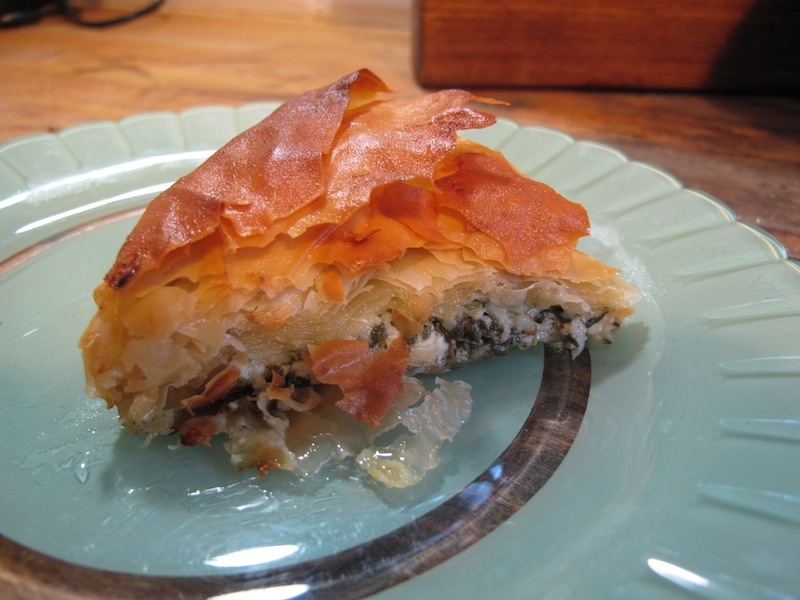 This is just a time consuming dish to prepare but was bloody lovely in the eating and good at any time of day. Pastry, eggs, cheese and spinach have all the hallmarks of a good breakfast and I thought the kids would love it. Unfortunately I hadn’t counted on their innate revulsion at anything dark green within their food – also, they said it taste very “sour”. Perhaps to a child’s pallet the melted feta was too lactic but I thought it was absolutely blinding and certainly my favourite breakfast of the Round The World Cooking project so far (we’ll get to Waffles later). Here’s how you make it:
This is just a time consuming dish to prepare but was bloody lovely in the eating and good at any time of day. Pastry, eggs, cheese and spinach have all the hallmarks of a good breakfast and I thought the kids would love it. Unfortunately I hadn’t counted on their innate revulsion at anything dark green within their food – also, they said it taste very “sour”. Perhaps to a child’s pallet the melted feta was too lactic but I thought it was absolutely blinding and certainly my favourite breakfast of the Round The World Cooking project so far (we’ll get to Waffles later). Here’s how you make it:
- 50ml Olive oil
- 1 packet filo pastry
- 500g spinach – like, 1 bag
- handful of finely chopped spring onions
- 2 tbs finely chopped dill
- 250g feta, crumbled
- 2 tbs milk
- 2 eggs beaten
- 100g melted butter
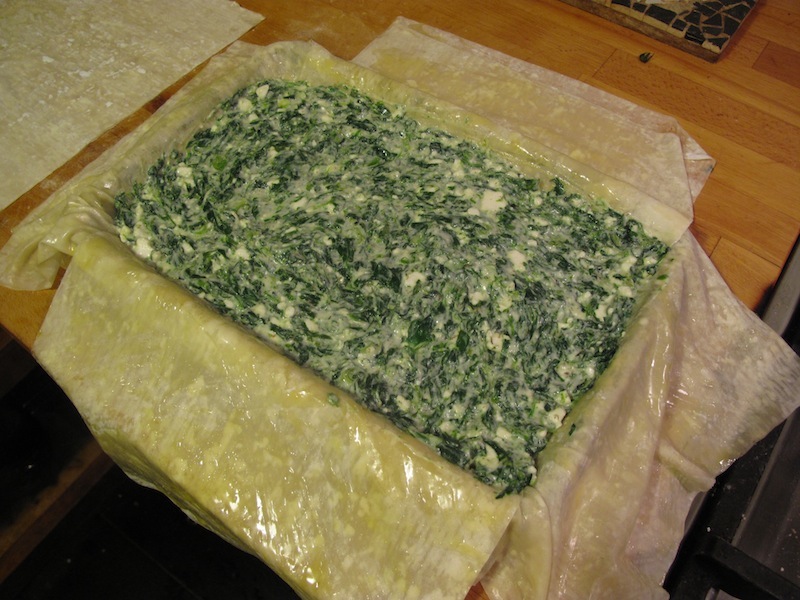 Set the oven to 180 degrees C. Brush a baking tin around 9in x 6in and 1 inch deep with olive oil.
Set the oven to 180 degrees C. Brush a baking tin around 9in x 6in and 1 inch deep with olive oil.
Remove any tough stalks then chop the spinach and blanch for 1 minute. Drain and squeeze out the water. Allow to cool for a couple of minutes and then add to all the other filling ingredients.
Start laying the filo sheets in the tin. Every sheet needs to be brushed with oil. Because of the shape of the pan I lay each sheet perpendicular to the next and allowed the ends of the filo sheet to drape over the edge.
Once you’ve laid half the sheets in, spread the filling evenly over the top and cover with the remaining filo sheets, remembering to brush each one with oil again.
Fold any overlapping sheets over the top and then score into 12 rectangles so it’s easy to serve once cooked. Brush the top with oil and spray with a little water – one of those plant sprayers is good for this job but for God’s sake don’t use one with Phostrogen or weed killer in it.
Cook for around 30 – 40 minutes or until golden brown.
Lunch: Chicken Soup Avogolemono (Kotosoupa Avgolemono)
- 1 small chicken, 1.5kg
- 3 tbs olive oil
- 1 small carrot, halved
- 1 small onion, chopped
- 1 celery stick
- 150g white rice – I use Jasmine rice because I love Thai food the most.
- 2 eggs
- 6 tbs lemon juice
Take the skin off the chicken, rinse and dry inside and out. My tip is to take the breasts off the chicken and then add later, so they don’t get overcooked.
Put in a pan with the vegetables and oil and cover with water. Bring to the boil and then simmer until cooked – pretty much when the meat is falling away from the bone.
Take the carcass out and pick off all the meat with a fork. Remove the veg too.
Add the rice to the stock and cook until tender – round about 15 minutes. I add the breasts whole at this stage too and then carve into pieces when cooked.
While the rice is cooking, beat the eggs and lemon juice together.
When the rice is cooked, slowly add the lemon egg mixture to the hot stock, whisking as you do it to stop the eggs from scrambling. The desired effect is a rich creamy stock with the sharpness from the lemon enhancing the savoury-ness of the chicken.
Add the chicken and veg back to the stock and serve.
My Big Fat Greek Dinner
The classic Greek thing is mezedes – small dishes – and my most awesome experience of this was at the Cypriot Club in Sydney where we were treated to around 3 hours of unrelenting new dishes – around 15 – 20 different items in total including all the usual dips, koupes (small hand grenade shaped snacks made of bulgar wheat), small parcels of kleftiko and lots and lots of Keo beer. But let’s not forget, Cyprus is a different country and that’s for another day.
I didn’t want to do complete run down of mezedes because I didn’t want to be stuck in the kitchen all evening – I had Ouzo to drink – so a couple of dips to nod in that direction, calamares and then a stupendous main course of organic lamb leg Kleftiko.
Taramasalata
I used to love taramasalata when I was a kid. In fact I remember going and buying it with my pocket money instead of sweets. Now, I hardly ever buy it – it’s one of those dishes that is very much of its day, a throwback to the 80s and anchored in time by this Smith and Jones clip.
But what a great dish and obviously concocted by fishermen (or fishermen’s wives more like) keen to make the most of a leftover product (the cod’s roe) with leftover bread.
This version is much more flavourful than shop bought and you need to adjust the ingredients to get the result you want – there’s no precise recipe, it has to be made according to taste. For example, mine was possibly a tad too strong but I didn’t have quite enough bread to pad it out. Also, I used extra virgin olive oil and found that to be a bit too bitter.
- Half a white loaf, one day old
- 200g smoked cod’s roe
- 2 tbs finely chopped onion
- 300ml vegetable oil
- 6 tbs lemon juice (to taste)
Cut the crusts off the bread and soak in a bit of water – don’t drown it, just enough to moisten. Leave it for a few minutes and then squeeze out.
Put the roe, onion and around a third of the oil into a food processor. While blending, add the bread a bit at a time along with the lemon juice. You might want to stop and taste every so often so you don’t dilute the roe too much and don’t get it too oily.
It should be pale pink, creamy and not too thick.
Hummus
It seems churlish not to include hummus. It might seem easy to get right but it’s one of those dishes that is so familiar that it immediately invites an opinion. My mistake in the past has been to omit the tahini which is essential to get it nice and smooth, and also to use too much extra virgin olive oil which can be too bitter.
I’d also hazard that tinned chickpeas are nowhere near as good as dried.
- 250g chickpeas
- 4 tbs tahini
- 1 large clove garlic, crushed to a paste
- 4 tbs olive oil
- 2 tbs lemon juice
- Salt and pepper to taste
Soak the chickpeas overnight. Drain and then boil for about a million years. OK, around 2 – 3 hours until soft. Don’t add salt as it can make them tough.
Drain and then puree in a food processor. Add the tahini and garlic and blend.
Drizzle in the oil and lemon juice while blending and stop every so often to taste.
Finally, season with salt and pepper to taste.
I served my dips with warmed up pitta bread and of course, the Ouzo.
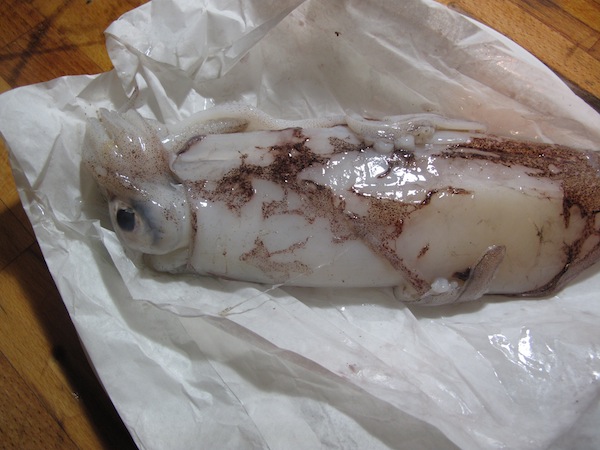 Calamari – honestly, do you need a translation for this one?
Calamari – honestly, do you need a translation for this one?
This has without a shadow of a doubt been the most successful dish so far – as far as the kids are concerned anyway – and at time of writing we’re midway through a St Patrick’s day Irish culinary odyssey.
The squid I got was exceptionally fresh. We’re lucky enough to have an exceptional fishmonger in nearby Ashburton – The Fish Deli – and it’s worth the trip to get fish that was landed that morning and frequently some pretty unusual stuff.
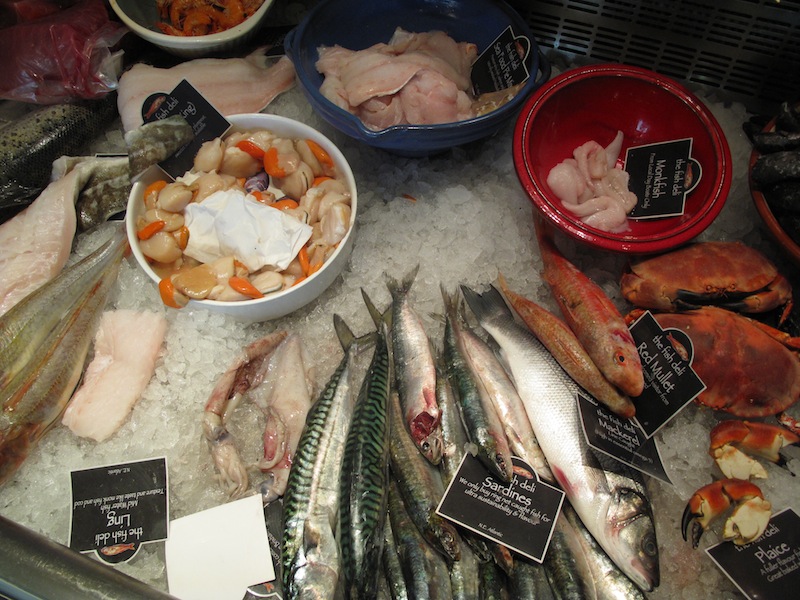 You can see how squid is dealt with here:
You can see how squid is dealt with here:
I used one large squid for a very small portion each for 8 people.
Batter ingredients:
- 100g plain white flour
- 1 tbs olive oil
- 250ml beer or fizzy water
- 2 egg whites
The quantities above seem very exact but to be honest it’s like pancake batter – once you get an idea of how it is you can just throw it together.
Put the flour and oil in together and then add the beer or water. Don’t overmix. You can vary the quantity of liquid depending on how thick you like the batter. Let it rest for about an hour. When you’re ready to cook, whisk the egg whites to soft peaks and then fold into the batter.
Heat up your deep fat fryer or do it in a wok like I do with around 2 inches deep of vegetable oil. Test one piece of batter out first – it should crisp up pretty quickly (1 – 2 minutes) but not burn or go too dark. It’s a fine balancing act.
Dip a handful of squid rings in the batter and then add one by one to the oil in batches, separating them out gently with a chopstick so they don’t stick together.
Drain on kitchen roll and then serve with wedges of lemon. Lush.
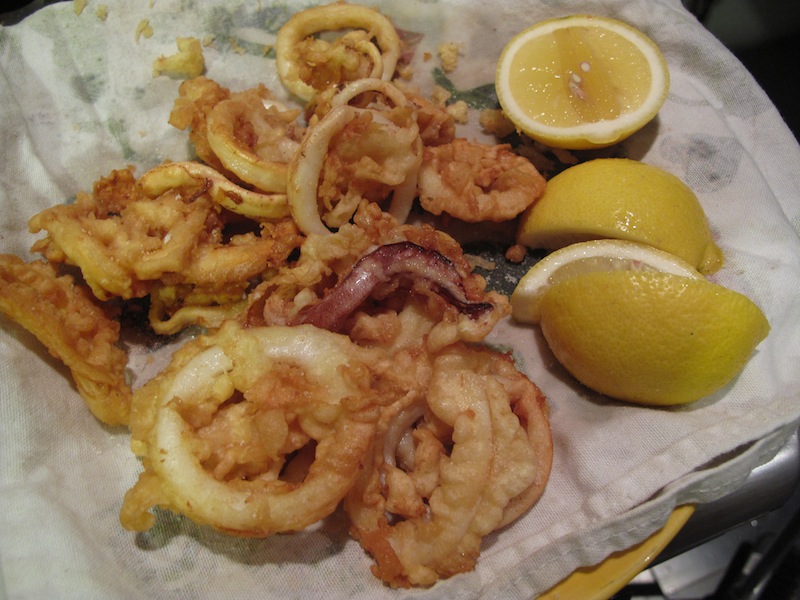 Stolen Meat
Stolen Meat
The main event of our Big Fat Greek Dinner is kleftiko. It means “stolen meat” and, according to Vefa’s Kitchen the name comes from the time of the Ottoman Empire when Greek freedom fighters hiding in the mountains would steal lamb, wrap it in its own skin and cook it in embers buried in the ground so the cooking smell wouldn’t reveal their location.
It’s an outstanding dish – really, really simple to make and – I think – a better version of the traditional roast lamb. You get left with delicious juices inside the cooking paper – I came downstairs the next day to find they had congealed into a jelly that was exceptionally tasty. You can also use the leftovers for kebabs the day after.
- 1 leg of lamb
- 150 olive oil
- 3 – 4 cloves of garlic, cut into thin slivers
- a good handful of fresh oregano, rough chopped
- juice of a lemon
Heat the oven to around 240 degrees C.
Heat a few spoonfuls of olive oil in a roasting tin and brown the lamb all over. Remove.
When cool, make small slits in the meat all over and push a sliver of garlic into each one. This is easiest if you use the knife blade to hold open the slit and push the garlic in. When you’ve done rub all over with olive oil.
Cut three pieces of baking parchment around 1m long and criss cross in a roasting tin.
Put the lamb inside, season with salt and pepper and sprinkle with oregano and lemon juice. Then fold all the layers over and fold tightly shut.
Roast for 20 minutes on the high heat then turn down to around 180 degrees C and roast for 30 minutes per kilo.
Let it rest for 30 minutes before serving. Never leave out this stage – it’s essential for a great roast of any kind.
Serve with roast potatoes.
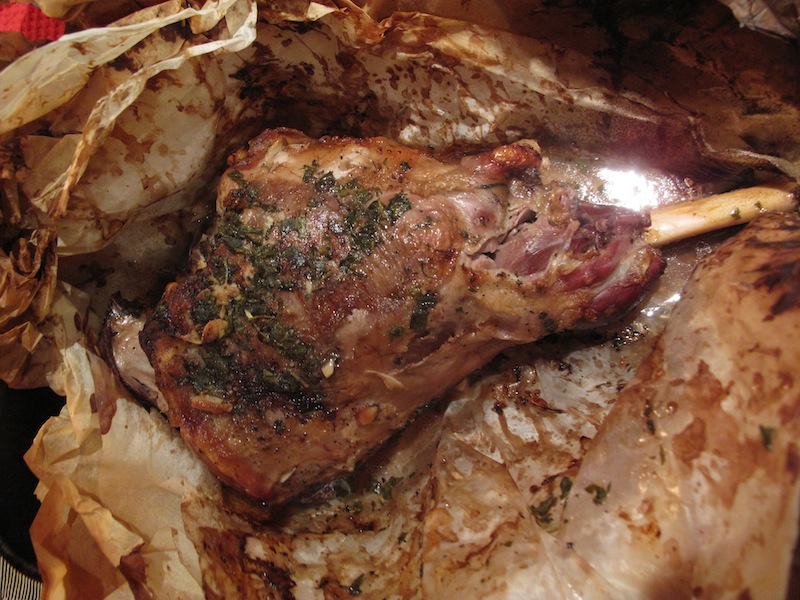 Pudding – Baklava
Pudding – Baklava
Syrupy, tongue tingly sweet, amazing with bitter coffee. I literally ate half a tray of this, much to my kids’ annoyance.
Ingredients:
Syrup:
- 75g honey
- 100g caster sugar
- 1/2 lemon, zest and juice
Put 100ml of water and the rest of the ingredients in a pan and boil it until thick and syrupy. Allow to cool.
Baklava:
- 100g walnuts, finely chopped
- 100g almonds, skinned and finely chopped
- 1 tbs cinnamon
- 200g butter, melted
- 400g (one pack) filo pastry
Mix together the nuts and cinnamon. Brush a baking tray (the one I used is around 25cm by 15cm and around 2.5cm deep) with melted butter.
Cut the filo sheets to the shape of the tray. Lay each filo sheet on the next and brush with butter. When you have six layers, scatter over about a third of the nut mixture then top with another sheets of pastry remembering to brush each one with butter again.
Repeat until you’ve got three layers of nut mixture and then top with the remaining pastry – around 4 layers. Brush the top with butter and put in the fridge for 10 minutes.
Cut the baklava into small squares so it’s easy to serve once cooked.
Bake in the oven at 180 degrees C for around 30 minutes then turn down to 140 degrees C for a further 20 minutes or so or until golden brown.
While it’s still hot pour the syrup over the whole tray and allow to cool slightly before serving.
Music
Cooking done, you can now relax with the remainder of your bottle of Ouzo and kick back to some stomping Greek tunes.
Aphrodite’s Child
Http://www.youtube.com/watch?v=3KCbqhJt16k
Demis Roussos
“My Red Apple” – a love song about a man that wants to meet the woman he loves but always finds the door and windows of her house closed.
“Once Upon A Time”
A love song about a woman that longs to see her lover
And let’s not forget probably the most famous Greek music, Zorba the Greek. The main theme has become something of cliche but this is a great album.



